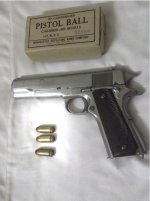WaR ~J~ CrImInAl -- I'm not sure why you selected that name, but it does put a few people on edge on this side of the pond. Hopefully you mean it only in humor.
Your Colt: It would be nice to see the other side to see if any markings are left on the slide or frame. From appearances, this is a 1911-A1. The primary difference is the scalloped cuts behind the trigger to ease access to the trigger and the slightly arched mainspring housing at the bottom rear of the grip. Your pistol still has the lanyard-ring at the bottom rear of the grip. A cord was attached to this ring and then to the user's belt to retain the gun if dropped during a fight. (Most U.S. soldiers did not use it however).
Your pistol was likely made during WW-II and issued to U.S. Army troops stationed in the middle eastern theatre of operations. Typically, a handgun was only issued to officers and specialty crews, such as armored vehicle crews, some artillery crews and Military Police.
Be kind to that pistol as it is over 65 years old and from the looks of it, has seen many years of use or handling. That box of ammunition does have some collector's value. It may be possible to trace the lot number (22368) to either WW-II, Korea or some later era. These are seldom found in such nice shape. I hope the ammunition inside is original and still contains 50 cartridges.
I would make sure a very good gunsmith inspects your gun before firing to make sure it is safe to operate and parts are not worn out. Parts are plentiful here in America and probably still in many places in the world.
You should only use standard velocity .45 ACP ammuntion (230 grain ball or fully jacketed at about 869 fps). [metric: 11.4mm, 14.9 gm, 265 m/s] to avoid stressing the gun.


